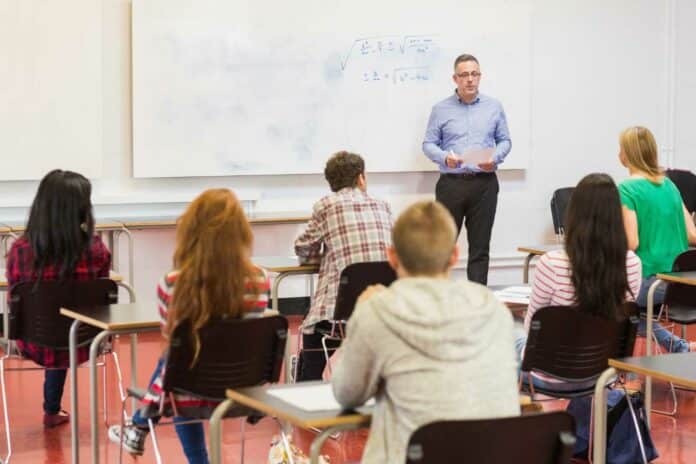Thanks to live streaming and recorded lectures, students can easily follow a lesson without ever entering the classroom. However, three EPFL surveys and a University of Geneva study indicate that most students still favor attending classes on campus.
The study investigated how live streaming affected students’ academic performance and attendance. 1,459 Bachelor’s students enrolled in the economics and management program at the University of Geneva participated in the 2017 study. Three groups were randomly selected from among these students:
- No Access Group (15%): Students in this group were never provided access to the live streaming service for their classes.
- Always Access Group (15%): Students in this group consistently had access to the live streaming service for all their classes.
- Selective Access Group (70%): Students in this group were allowed access to the service only during certain weeks, randomly chosen.
Paula Cacault, Head of Operations at the EPFL’s Enterprise for Society Center (E4S) © Alain Herzog 2023 EPFL said, “We thought students would rush to use the streaming service whenever they could thought students would rush to use the streaming service whenever they could. But as it turned out, just 10% of them took advantage of it.”
After analyzing students’ exam grades, the study authors observed a notable trend: live streaming generally had a positive effect on the grades of high-achieving students but had the opposite effect on the grades of low-achieving students. This finding aligns with existing literature, suggesting that students already struggling academically may face additional challenges when exposed to non-traditional teaching methods such as live streaming.
After examining student exam results, the study’s authors noticed a noteworthy pattern: live streaming typically improved high achievers’ grades while having the reverse effect on low performers’ grades. The literature indicates that students struggling tend to do worse when professors stray from conventional teaching methods.
The surveys carried out by Associate Vice President for Education Pierre Dillenbourg of EPFL, in association with the Teaching Support Center (CAPE) and LEARN Center of EPFL, provided insight into how student preferences for learning methods are changing. A sizable number of students responded to these surveys conducted in June 2022, November 2022, and June 2023: 2,700 in June 2022, 2,900 in November 2022, and 1,400 in June 2023.
The findings showed that student behavior had changed, especially in-person attendance. A sizable percentage of students already enrolled at EPFL before the epidemic stated that they attended classes in person less frequently. More than half of these students reported fewer in-person attendance (62.6% in June 2022 and 51.6% in November 2022).
Interestingly, in-person attendance showed seasonal fluctuations, with fall seeing more excellent rates than other periods of the year. 74.7% of respondents said they “always” or “often” attended in-person sessions in November 2022, compared to 57.4% in June 2022 and 61.7% in June 2023.
Even with the availability of online lectures, a significant percentage of students (52%, mean, throughout the three polls) reported that they continued to visit the campus. The desire to work on projects, study, or attend social events was the main driving force behind these visits, highlighting the ongoing significance of the campus setting for student involvement and interpersonal communication.
Pierre Dillenbourg, Associate Vice President for Education © EPFL, said, “While students appreciate it when professors make recordings of their lectures available online, that doesn’t prevent them from attending the class in person. We were curious to see how students kept on top of the subject matter when they didn’t come to class, and we found that they used handouts, textbooks, and slides just as much as they used recorded lectures. So these recordings aren’t a decisive factor for in-person attendance.”
Because the professors in these seminars lead activities beyond what is covered in the recorded lectures, students usually attend sessions that they find particularly engaging, challenging, or exciting. Pupils have higher expectations now that the pandemic has struck. They desire dynamic learning environments, where being physically present in a classroom adds value. But has the learning of skills been hampered by this selective attitude toward attendance?
Dillenbourg said, “The surveys were anonymous, so we couldn’t establish a link between reported in-person attendance and exam grades.”
“However, studies in other countries have shown that the correlation could be stronger, except for first-year students and for classes that involve hands-on experiments. But of course, our goal at EPFL is for students to take full advantage of our great campus to learn from each other and interact with their professors.”
Cacault thinks more research is necessary to determine whether these new learning habits have made the achievement gap between high-achieving and low-achieving kids wider.
Journal Reference:
- Cacault, M. Paula; Hildebrand, Christian; Laurent-Lucchetti, Jérémy; and Pellizzari, Michele (2021). “Distance learning in higher education: Evidence from a randomized experiment.” Journal of the European Economic Association, 19(4): 2322–2372. DOI: 10.1093/jeea/jvaa060
